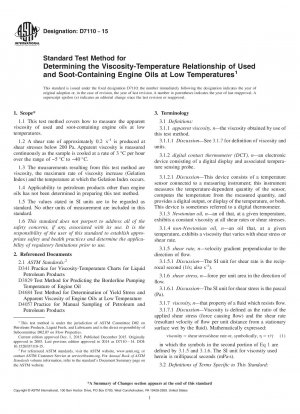ASTM D7110-15
Standard Test Method for Determining the Viscosity-Temperature Relationship of Used and Soot-Containing Engine Oils at Low Temperatures
- Standard No.
- ASTM D7110-15
- Release Date
- 2015
- Published By
- American Society for Testing and Materials (ASTM)
- Status
- Replace By
- ASTM D7110-20
- Latest
- ASTM D7110-21
- Scope
5.1 Significance of Low Temperature, Low Shear Rate, Engine Oil Rheology—The low-temperature, low-shear viscometric behavior of an engine oil, whether new, used, or sooted, determines whether the oil will flow to the sump inlet screen, then to the oil pump, then to the sites in the engine requiring lubrication in sufficient quantity to prevent engine damage immediately or ultimately after cold temperature starting. Two forms of flow problems have been identified,3 flow-limited and air-binding behavior. The first form of flow restriction, flow-limited behavior, is associated with the oil's viscosity; the second, air-binding behavior, is associated with gelation.
5.2 Significance of the Test Method—The temperature-scanning technique employed by this test method was designed to determine the susceptibility of the engine oil to flow-limited and air-binding response to slow cooling conditions by providing continuous information on the rheological condition of the oil over the temperature range of use.3,4,5 In this way, both viscometric and gelation response are obtained in one test.
Note 1: This test method is one of three related to pumpability related problems. Measurement of low-temperature viscosity by the two other pumpability test methods, D3829 and D4684, hold the sample in a quiescent state and generate the apparent viscosity of the sample at shear rates ranging up to 15 s-1 and shear stresses up to 5258201;Pa at a previously selected temperature. Such difference in test parameters (shear rate, shear stress, sample motion, temperature scanning, and so forth) can lead to differences in the measured apparent viscosity among these methods with some test oils, particularly when other rheological factors associated with gelation are present. In addition, the three methods differ considerably in cooling rates.
5.3 Gelation Index and Gelation Index Temperature—This test method has been further developed to yield parameters called the Gelation Index and Gelation Index Temperature. The first parameter is a measure of the maximum rate of torque increase caused by the rheological response of the oil as the oil is cooled slowly. The second parameter is the temperature at which the Gelation Index occurs.
1.1 This test method covers how to measure the apparent viscosity of used and soot-containing engine oils at low temperatures.
1.2 A shear rate of approximately 0.28201; s-1 is produced at shear stresses below 200 Pa. Apparent viscosity is measured continuously as the sample is cooled at a rate of 38201;°C per hour over the range of −58201;°C to −408201;°C.
1.3 The measurements resulting from this test method ......
ASTM D7110-15 Referenced Document
- ASTM D341 Standard Test Method for Viscosity-Temperature Charts for Liquid Petroleum Products
- ASTM D3829 Standard Test Method for Predicting the Borderline Pumping Temperature of Engine Oil
- ASTM D4057 Standard Practice for Manual Sampling of Petroleum and Petroleum Products
- ASTM D4684 Standard Test Method for Determination of Yield Stress and Apparent Viscosity of Engine Oils at Low Temperature
ASTM D7110-15 history
- 2021 ASTM D7110-21 Standard Test Method for Determining the Viscosity-Temperature Relationship of Used and Soot-Containing Engine Oils at Low Temperatures
- 2020 ASTM D7110-20 Standard Test Method for Determining the Viscosity-Temperature Relationship of Used and Soot-Containing Engine Oils at Low Temperatures
- 2015 ASTM D7110-15 Standard Test Method for Determining the Viscosity-Temperature Relationship of Used and Soot-Containing Engine Oils at Low Temperatures
- 2014 ASTM D7110-14 Standard Test Method for Determining the Viscosity-Temperature Relationship of Used and Soot-Containing Engine Oils at Low Temperatures
- 2005 ASTM D7110-05a(2011) Standard Test Method for Determining the Viscosity-Temperature Relationship of Used and Soot-Containing Engine Oils at Low Temperatures
- 2005 ASTM D7110-05a Standard Test Method for Determining the Viscosity-Temperature Relationship of Used and Soot-Containing Engine Oils at Low Temperatures
- 2005 ASTM D7110-05 Standard Test Method for Determining the Viscosity-Temperature Relationship of Used and Soot-Containing Engine Oils at Low Temperatures

Copyright ©2024 All Rights Reserved